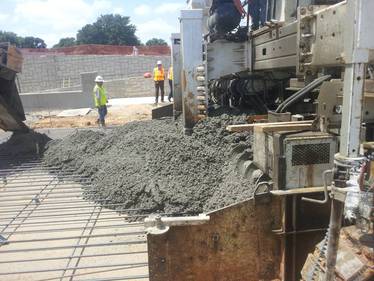Applying The Box Test in The Field

Introduction
Throughout the United States, concrete has been used to create the transportation infrastructure of highways and bridges. Currently, owners specify the desired strength and durability for a concrete mixture. However, one important performance criteria that is not specified is the workability of the concrete. To find the right workability, contractors typically have to make a large number of concrete mixtures. Furthermore, the concrete mixture developed may not work with other materials.
Problem
When mixtures have insufficient workability, it is common to increase the cement and water content of the mixture. This can increase cost and decrease the sustainability and durability of the concrete. It is desirable to minimize the paste content in a concrete mixture because it reduces the cost of the project while minimizing CO2 emissions. Although tests exist to evaluate the strength and durability of a mixture, only a few reliable tests can evaluate the workability. For highways, a useful test evaluating the performance of a concrete mixture for a slip formed paving machine did not exist.
Solution
While the workability of a mixture can be affected by many different variables, no tool exists that allows a quantitative impact of these variables for concrete pavements. A concrete mixture for a slip formed pavement must be stiff enough to hold an edge after leaving the paver, but workable enough to be consolidated.
With funding from Oklahoma Transportation Center and the Oklahoma Department of Transportation, a straight forward and inexpensive test was developed to evaluate the ability of a concrete mixture to be placed with a slip form paver. This test can be used with a simple procedure to provide valuable tools in quantifying the impacts of many workability variables. It is important to realize not all processes of a slip formed paver can be or should be mimicked for expense and complexity. Instead, the focus of this work is to simulate the important components of the paving process.
Application
Funding of $16 million from the FHWA for the Highways for Life Program constructed 2.2 miles of pavement in Forth Worth, Texas. Using the developed workability test, a concrete mixture was created that allowed a lower amount of paste, but still have the desired workability. Shown below in the Figure the concrete mixture was easily placed and finished by a slip formed paving machine.
Benefits
Since Oklahoma Transportation Center and Oklahoma Department of Transportation helped fund this developed workability test, it created a valuable workability test. As shown in Fort Worth, TX, the lower cement mixture created a 10% reduction in overall cost and a 25% reduction in CO2 emissions by reducing the amount of cement used. Also, it increased the life-expectancy of the concrete pavement.
Throughout the United States, concrete has been used to create the transportation infrastructure of highways and bridges. Currently, owners specify the desired strength and durability for a concrete mixture. However, one important performance criteria that is not specified is the workability of the concrete. To find the right workability, contractors typically have to make a large number of concrete mixtures. Furthermore, the concrete mixture developed may not work with other materials.
Problem
When mixtures have insufficient workability, it is common to increase the cement and water content of the mixture. This can increase cost and decrease the sustainability and durability of the concrete. It is desirable to minimize the paste content in a concrete mixture because it reduces the cost of the project while minimizing CO2 emissions. Although tests exist to evaluate the strength and durability of a mixture, only a few reliable tests can evaluate the workability. For highways, a useful test evaluating the performance of a concrete mixture for a slip formed paving machine did not exist.
Solution
While the workability of a mixture can be affected by many different variables, no tool exists that allows a quantitative impact of these variables for concrete pavements. A concrete mixture for a slip formed pavement must be stiff enough to hold an edge after leaving the paver, but workable enough to be consolidated.
With funding from Oklahoma Transportation Center and the Oklahoma Department of Transportation, a straight forward and inexpensive test was developed to evaluate the ability of a concrete mixture to be placed with a slip form paver. This test can be used with a simple procedure to provide valuable tools in quantifying the impacts of many workability variables. It is important to realize not all processes of a slip formed paver can be or should be mimicked for expense and complexity. Instead, the focus of this work is to simulate the important components of the paving process.
Application
Funding of $16 million from the FHWA for the Highways for Life Program constructed 2.2 miles of pavement in Forth Worth, Texas. Using the developed workability test, a concrete mixture was created that allowed a lower amount of paste, but still have the desired workability. Shown below in the Figure the concrete mixture was easily placed and finished by a slip formed paving machine.
Benefits
Since Oklahoma Transportation Center and Oklahoma Department of Transportation helped fund this developed workability test, it created a valuable workability test. As shown in Fort Worth, TX, the lower cement mixture created a 10% reduction in overall cost and a 25% reduction in CO2 emissions by reducing the amount of cement used. Also, it increased the life-expectancy of the concrete pavement.
Slide Show of the Optimized Graded Concrete Being Placed
